This post may contain affiliate links. Please read our disclosure policy.
When you’re cooking for one or two, large recipes can feel overwhelming. The good news is that scaling down a recipe doesn’t have to be complicated. Whether you’re halving ingredients, reducing serving sizes, or just trying to avoid leftovers, this simple guide will show you how to adjust recipes to fit your needs.

Table of Contents
- Easy Conversion Chart For Reducing Recipes
- Cooking Conversion Guide: Easy Tips for Halving Recipes
- Essential Tools For Measuring And Scaling Down Recipes
- Choosing The Right Cookware When Reducing Recipes
- How To Halve An Egg For Smaller Recipes
- Expert Tips For Scaling Down Recipes
- How To Adjust Slow Cooker Sizes For Smaller Recipes
- How Reducing A Recipe Affects Cooking Time
- Top Small Batch And Single Serving Recipes To Try
Cooking for one or two doesn’t mean you have to make enough to feed six. If you’ve ever found yourself stuck with a recipe that makes too much, you’re not alone. I specialize in single serving and small batch recipes and can show you how to scale down any recipe so you can enjoy homemade meals without the extra leftovers. Let’s get started!
Easy Conversion Chart For Reducing Recipes
Scaling down a recipe is easier than you think. Use this simple chart to quickly convert common measurements when halving or reducing recipes. Whether you’re cutting a recipe from 4 servings to 2 or adjusting for just one or two people, this guide takes out the guesswork and keeps the math simple. (Click on the image to download it):
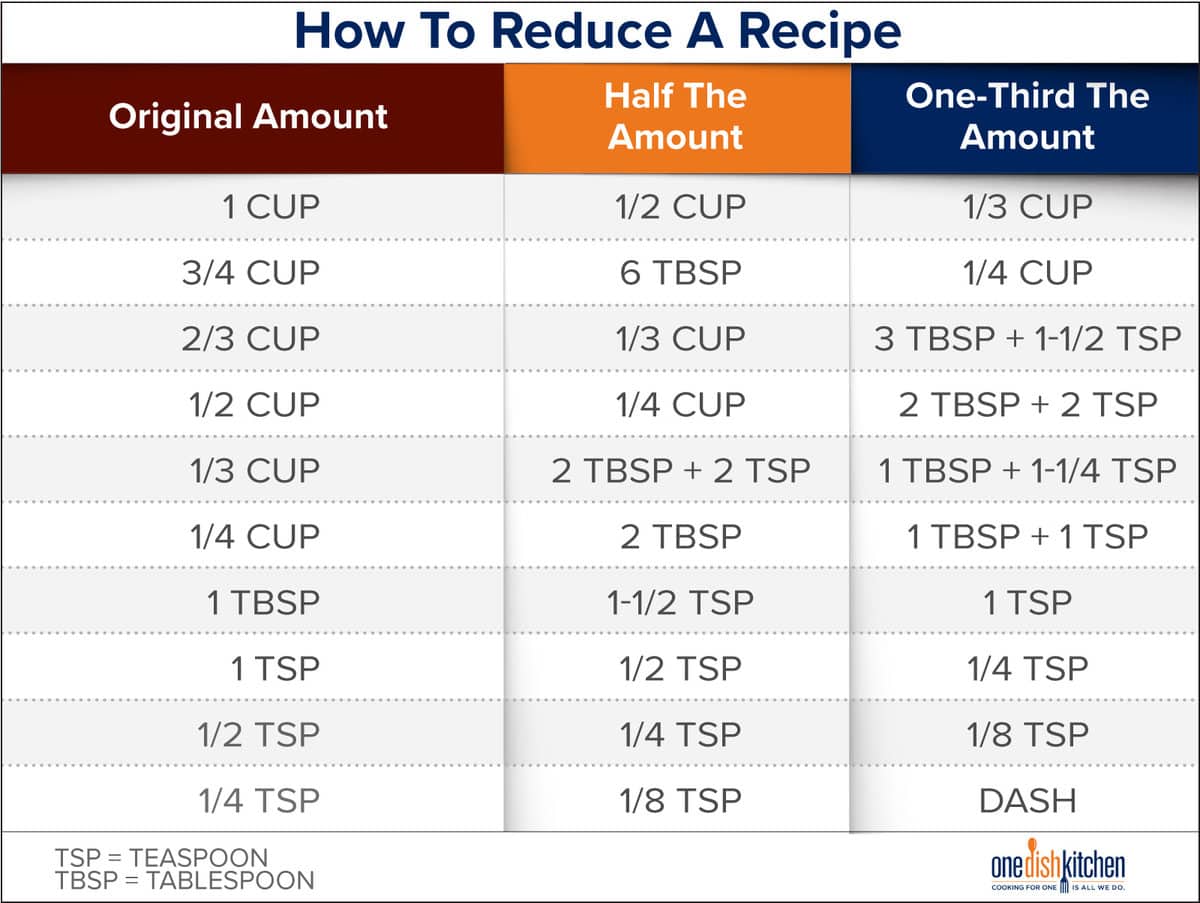
Cooking Conversion Guide: Easy Tips for Halving Recipes
Simple measurements like halving 2 cups to 1 cup are easy, but trickier amounts can be confusing. A helpful tip is to convert to smaller units like tablespoons and teaspoons, which are easier to divide.
Key Measurement Conversions for Reducing Recipes:
- 1 cup = 16 tablespoons (tbsp) = 48 teaspoons (tsp)
- Half of 1 cup = 8 tablespoons = 24 teaspoons
- 3/4 cup = 12 tablespoons
- Half of 3/4 cup = 6 tablespoons
- 1/2 cup = 8 tablespoons
- Half of 1/2 cup = 4 tablespoons
- 1/3 cup = 5 tablespoons + 1 teaspoon
- Half of 1/3 cup = 2 tablespoons + 2 teaspoons
- 1/4 cup = 4 tablespoons
- Half of 1/4 cup = 2 tablespoons
- 1/8 cup = 2 tablespoons
- Half of 1/8 cup = 1 tablespoon
- 1 tablespoon = 3 teaspoons
- 1/2 tablespoon = 1 1/2 teaspoons
For Fluids and Weights:
- 8 fluid ounces (fl oz) = 1 cup
- 1 pint (pt) = 2 cups
- 1 quart (qt) = 2 pints
- 4 cups = 1 quart
- 1 gallon (gal) = 4 quarts
- 16 ounces (oz) = 1 pound (lb)
- 1 ounce = 28 grams
- 1 pound = 454 grams
Expert Tip: The key to easily reducing a recipe is to remember the number of tablespoons in a cup and the number of teaspoons in a tablespoon. With these in mind, you can confidently scale down any recipe.
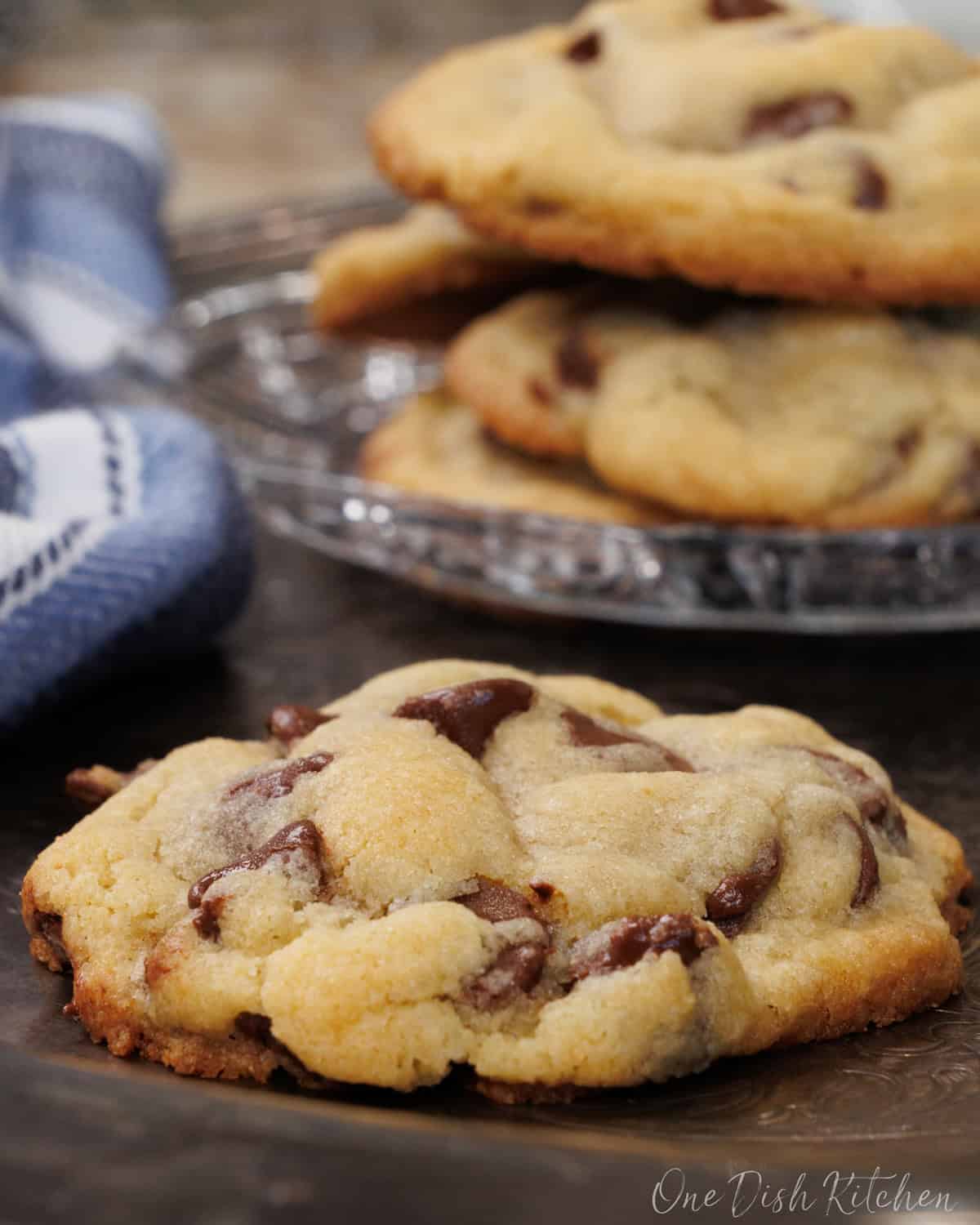
Essential Tools For Measuring And Scaling Down Recipes
The right tools make reducing a recipe much easier. Here are the key measuring tools every home cook should have.
- Dry Measuring Cups: These are your best friends for measuring dry ingredients like flour, sugar, and nuts. A standard set typically includes sizes of 1 cup, 3/4 cup, 1/2 cup, 1/3 cup, and 1/4 cup.
- Liquid Measuring Cup: Designed for wet ingredients such as water, milk, and broth, a liquid measuring cup is essential for accurate recipe adjustments.
- Measuring spoons: For dealing with smaller quantities – think spices, salt, and extracts – measuring spoons are indispensable.
- Kitchen Scale: If you’re looking for the utmost accuracy, a kitchen scale is the way to go. It’s especially useful for halving recipes. Simply take the weight specified in the original recipe and divide it. Want to make a half batch? Divide the ingredient weights by two. Going for a quarter batch? Divide by four.
Choosing The Right Cookware When Reducing Recipes
When scaling down a recipe, using the right size cookware is key. A dish that’s too large can lead to overcooked or dried-out food. Use this quick guide to choose the best equipment for smaller portions.
Here’s what we recommend:
- Skillet: Opt for an 8-inch or a 10-inch skillet for most stove-top cooking tasks.
- Baking dish: For smaller batches, a 5×5-inch dish with a base area of 25 square inches or a 4×6-inch dish with a 24-square-inch base are both solid choices. If a recipe specifies these sizes, you can also use a 6×6-inch dish, but be vigilant as it may cook faster.
- Ramekin: A 10-ounce ramekin is ideal for individual servings. It typically measures about 4 inches in diameter and is roughly 1 3/4 inches tall.
Expert Tip: Using the right cookware is key to successfully reducing recipes. A few quality, versatile pieces can make all the difference. For small-scale cooking, the most commonly used dishes are a 5×5-inch or 4×6-inch baking dish, a 10-ounce ramekin, and a 5×7-inch baking dish. To check out the specific cookware we recommend, visit our Store page.
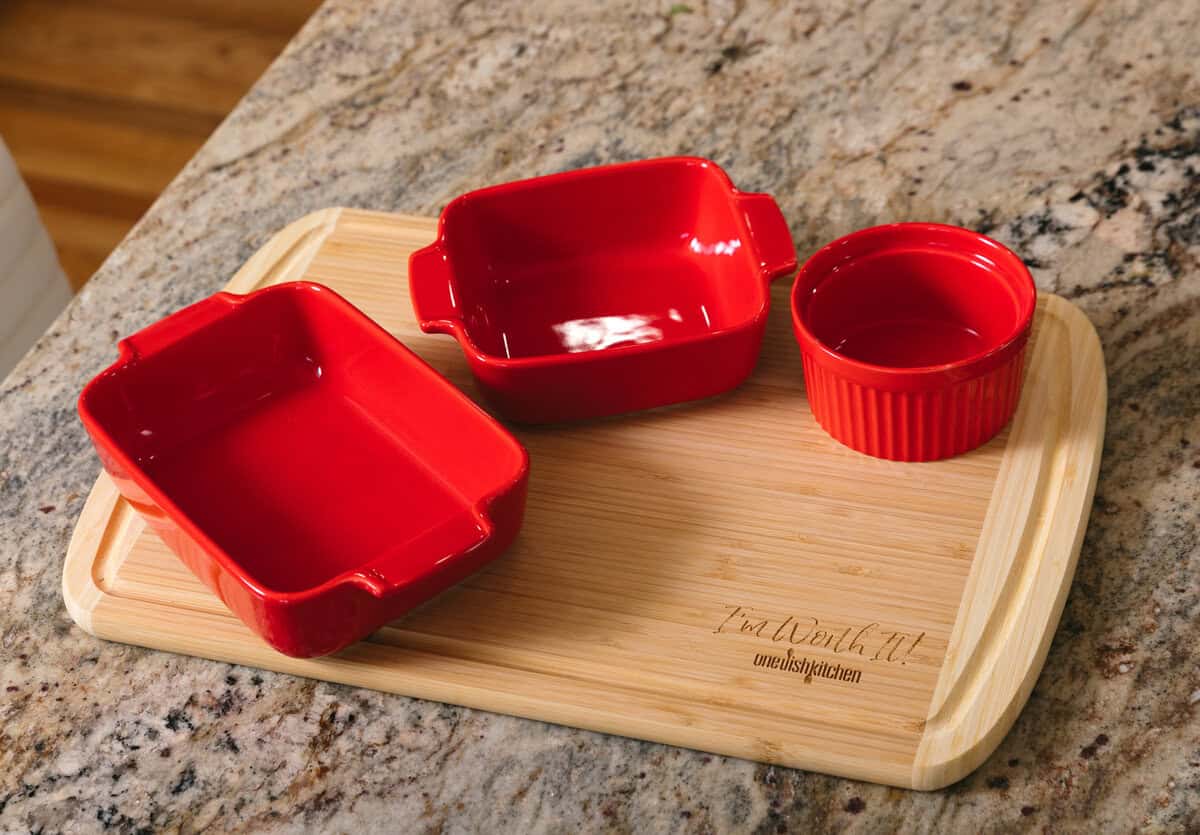
How To Halve An Egg For Smaller Recipes
Reducing a recipe can be tricky when it calls for a whole egg. Eggs play different roles in baking – whites add structure and lift, while yolks add richness and tenderness.
The egg white is mostly water and protein. When whipped, it creates a stable foam that helps baked goods rise. You’ll see this technique in recipes like our mini Texas sheet cake and small batch vanilla cupcakes, which rely on egg whites for their light texture.
The egg yolk, on the other hand, is rich in fat, protein, and nutrients. It adds moisture and a tender texture to baked goods. Recipes like our small batch cranberry orange scones and small batch chocolate chip cookie use just the yolk for a softer, richer result.
Through testing, we’ve found that using a whole egg in a small batch recipe can throw off both texture and flavor.
To halve an egg:
- Crack the egg into a small bowl.
- Whisk the yolk and white together.
- Measure out half and use it in your recipe.
If a recipe calls for multiple eggs, whisk them together first, then divide to get the amount you need.
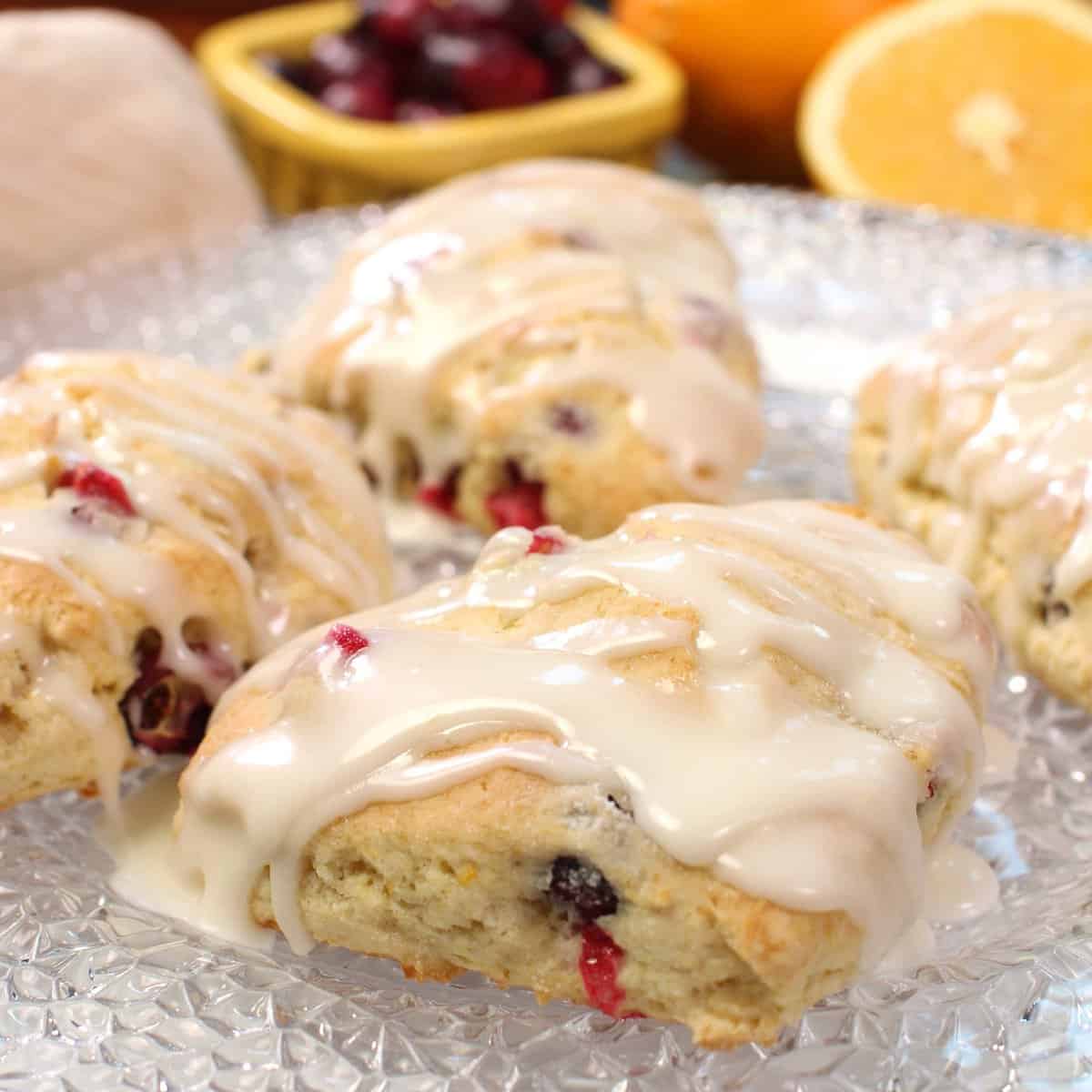
Expert Tips For Scaling Down Recipes
Scaling down recipes gets easier with practice, but these simple tips can help you get great results from the start:
- Calculate First: Before you begin, convert all ingredient amounts and write them down. This keeps you organized and avoids mistakes while cooking.
- Season Gradually: Start with about half the original amount of seasoning. Taste as you go and adjust to your liking.
- Use Proper Cookware: The size of your pan or baking dish matters. Using one that’s too large can lead to overcooked or dried-out food. Choose cookware that fits the reduced recipe.
How To Adjust Slow Cooker Sizes For Smaller Recipes
Halving a slow cooker recipe? Here’s how to make it work:
- Use a Smaller Cooker: If the original recipe uses a 6-quart slow cooker, switch to a 3-quart slow cooker or smaller. For single serving recipes, a 1.5-quart or 2-quart cooker works best.
- Make a Large Cooker Work: No small slow cooker? Place an oven-safe bowl inside your larger one to create a smaller cooking space. Be sure to check our full guide for tips on how to cook smaller meals using a large slow cooker.
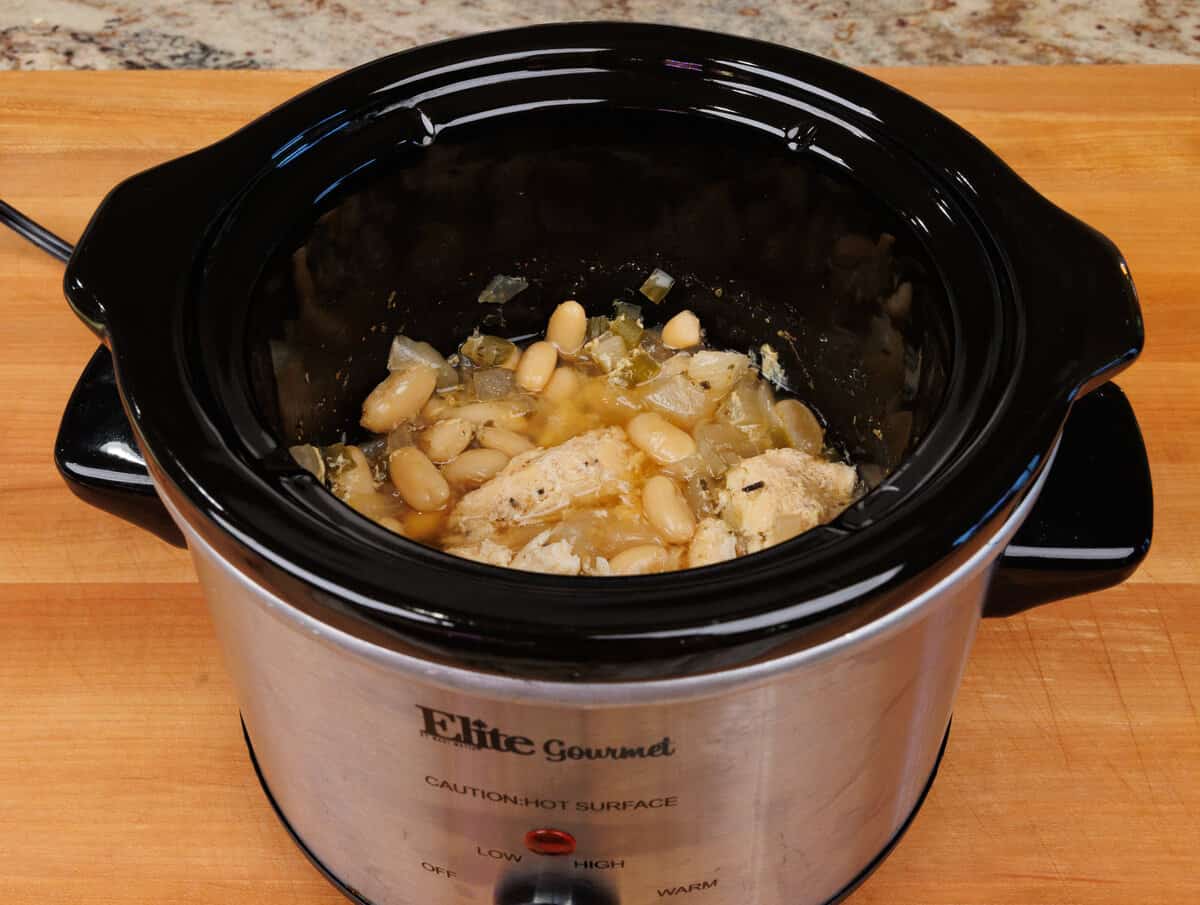
How Reducing A Recipe Affects Cooking Time
Lowering the amount of a recipe usually doesn’t require changing the oven temperature, but it can affect how long the food cooks:
- Cookies: No change needed. Bake for the same time as the full recipe.
- Cakes: They often bake faster when scaled down. Start checking 10–15 minutes earlier than the original time. Test doneness with a toothpick – if it comes out clean, the cake is done.
Top Small Batch And Single Serving Recipes To Try
Want to cook something delicious without leftover waste? These popular single serving and small batch recipes are just what you need:
- Pancakes Recipe For One
- Small Batch Chocolate Chip Cookies
- Banana Bread with One Banana
- Small Batch Brownies
- Chicken and Rice Casserole For One
- Small Batch Mashed Potatoes
- Mini Dutch Apple Pie
- Small Batch of Butter Pecan Granola
- Small Loaf of French Bread
- Mini Meatloaf
- Baked Ziti For One
- Shrimp Scampi For One
- Chicken Caprese For One
That’s your complete guide to reducing, halving, and scaling down recipes when cooking for fewer people. From sweet to savory, breakfast to dinner, these tips and recipes help you make perfectly portioned meals without sacrificing flavor. Now it’s time to put it all into practice – happy cooking!
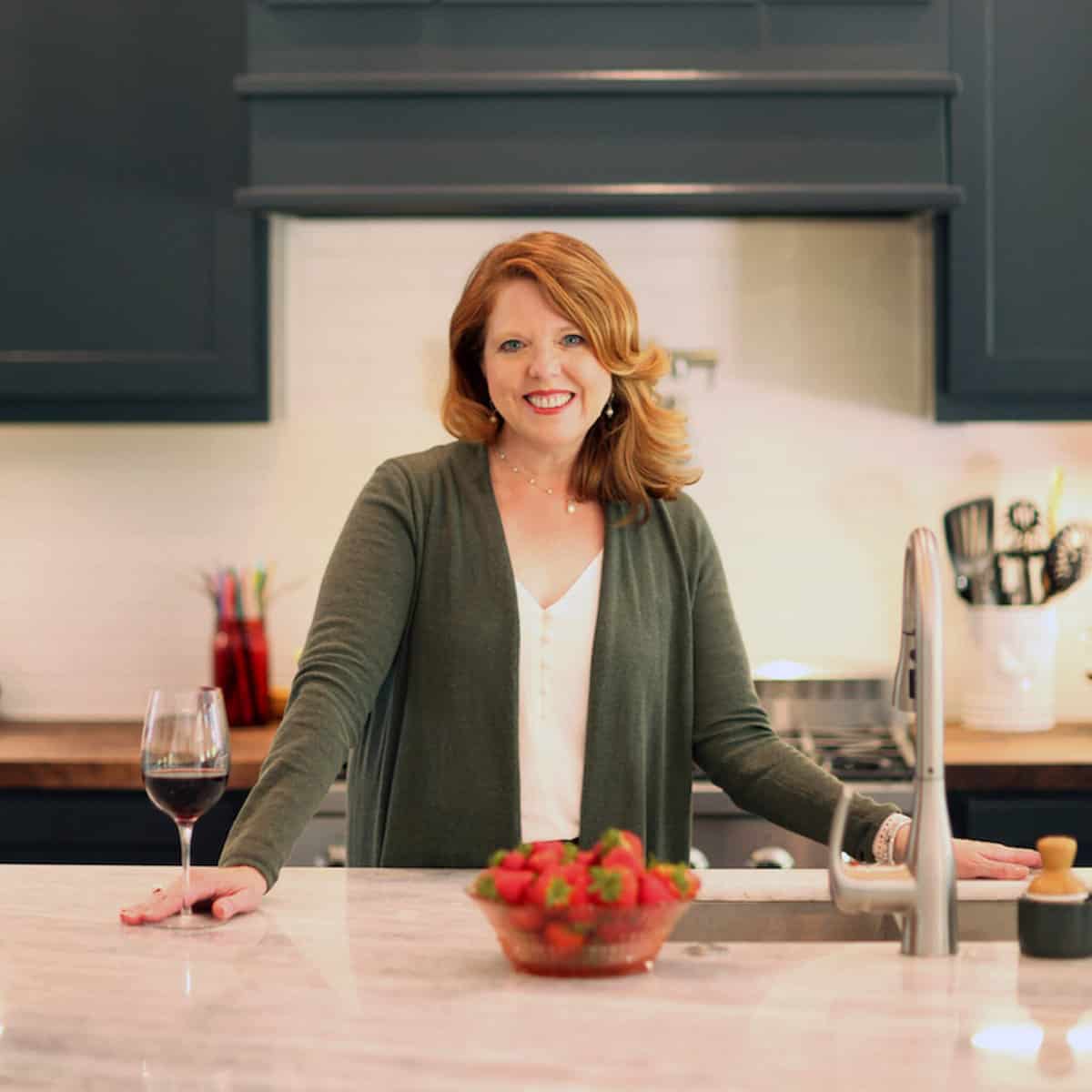
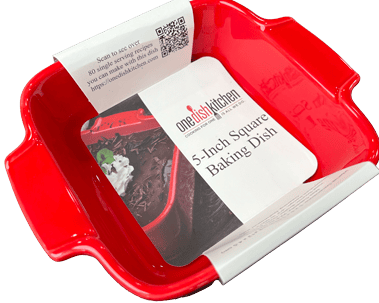








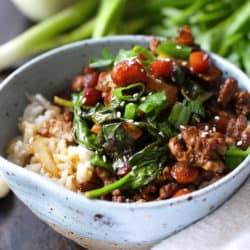
Thank you so much for doing this conversion explanation. I’ve often wondered how to do it. It is greatly appreciated.
Love your website – I always learn something new. I’m Canadian but.live in England. All recipes here are metric. Any chance you could provide a conversion chart for grams, etc.?
Thank you!
TERRIFIC article.
This is a great reference to keep on hand for making one serving dishes! Muchly appreciated.
Hi Joanie, when down sizing a recipe how do I calculate the smaller cookware, baking dish that should be used?
The baking dish sizes we use most often in our single serving and small batch recipes are a 5×5 inch, which has a base area of 25 square inches and holds a volume of approximately 20 ounces (measuring the amount of liquid the dish holds). A similar dish is a 4×6 inch which has a base area of 24 square inches. We also recommend using a 10 ounce ramekin.
When converting a recipe to a smaller pan, it really comes down to how much you need to reduce the recipe to fit in the smaller pan. For example, if you are starting with a 9 x 13 baking dish, it would have a base area of 117 inches. To make it work in a 5 x 5 baking dish you will need to reduce the recipe by 4 or 5 since dividing the square inches of the large pan by the square inches of the small page gives you 117 sq in/25sqin or 4.7. It may sound a bit complicated, but typically most dishes can be reduced by a factor of 4 to make them work in small baking dishes. You can also compare the change in volume to determine what you need to reduce the recipe by to make them work in the small baking dish. The cook times should be similar but you need to keep an eye out for it the first time you make it in a smaller dish.
Good morning. I love your site as there are just 2 of us to cook for most of the time and your recipes fit the bill nicely.
I appreciate the 2 charts you have included. I was wondering why you did not also include the gram conversions? When I bake, I always scale my ingredients as I have found this to be the only way to ensure consistent results. When I get a new recipe I always print it out and do the conversions prior to starting the baking process.
Thanks again for a great site.
This is so helpful thank you so much. I just love your Recipes and articles. I don’t cook much since I am almost 86 but still like to eat. You have a Merry Christmas and keep up the good job keeping us cooking.. God bless and keep you
This was an amazing article and I thank you Joanie! This is just what I needed!
This is excellent, so useful! Thank you so much for your hard work.
THIS IS ONE OF THE BEST, VERY INTERESTING, AND MOST INFORMATIVE ARTICLES, I’VE EVER SEEN — EVERYTHING ONE NEEDS TO KNOW ABOUT THE SUBJECT IS ALL IN ONE PLACE AND DEFINITELY WILL BE KEPT CLOSE BY WHEN COOKING — THANK YOU!!!, THANK YOU!!!, THANK YOU!!! ANYONE WHO COOKS SHOULD HAVE A COPY FOR QUICK AND EASY REFERENCE WHEN PREPARING FOOD…KEEP UP THE GOOD WORK — IT’S VERY MUCH APPRECIATED, ESPECIALLY BY MOST OF US ‘COOKING FOR ONE’, I’M SURE…AGAIN — THANK YOU…
I agree wholeheartedly with your comment. This article is a dream come true, and will be referred to countless times. I will also be using the delicious recipes from this website.